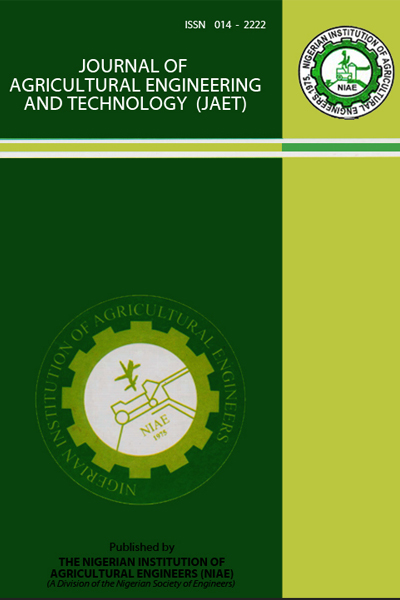FRICTIONAL PROPERTIES OF THE ROOTS OF THREE CASSAVA CULTIVARS
Keywords:
Coefficient of friction, coefficient of internal friction, coefficient rolling resistance, cortex, peridermAbstract
Frictional properties of cassava are needed in the design and development of machines for postharvest operations of cassava roots. Most postharvest processing operations of cassava tubers are still being done manually. Efforts at mechanizing these operations have recorded modest success due largely to scarce publications on the engineering properties of cassava, frictional properties of cassava inclusive. This study was conducted to determine the coefficients of friction, internal friction and rolling resistance of two improved cassava cultivars; TMS 30572, and TME 419 and TME 7 (locally called Oko iyawo) at five moisture levels of 40 - 60% (wet basis) at 5%
interval. The coefficients of friction and rolling resistance were determined on stainless steel, galvanized sheet and wood surfaces. The data were analyzed using ANOVA on SPSS 15. Mean coefficient of friction ranged from 0.20 - 0.28, 0.43 - 0.55 and 0.61 - 0.78 respectively on stainless steel, galvanized sheet and wood surfaces with positive linear relationship with moisture increase. A reverse trend was observed for coefficient of internal friction which ranged from 0.40 – 0.69 while the coefficient rolling resistance of the periderm, cortex and flesh of the tubers ranged from 0.14 - 0.15, 0.20 - 0.26 and 0.25 - 0.30; 0.10 - 0.13, 0.16 - 0.19 and 0.20 - 0.26, and 0.08 - 0.09; 0.12 - 0.1 and 0.15 - 0.19 on stainless, galvanized and wood respectively. Moisture content significantly influenced the coefficients of friction and internal friction while skin coverings of the roots significantly influenced the coefficient of rolling resistance of the roots. The study provided useful data essential for the design and development of effective cassava processing and handling machines.


